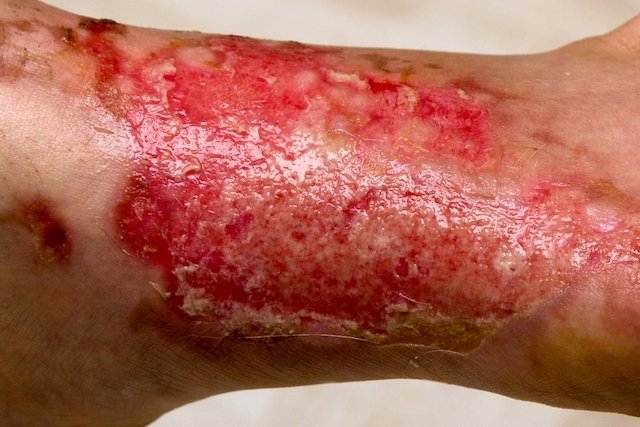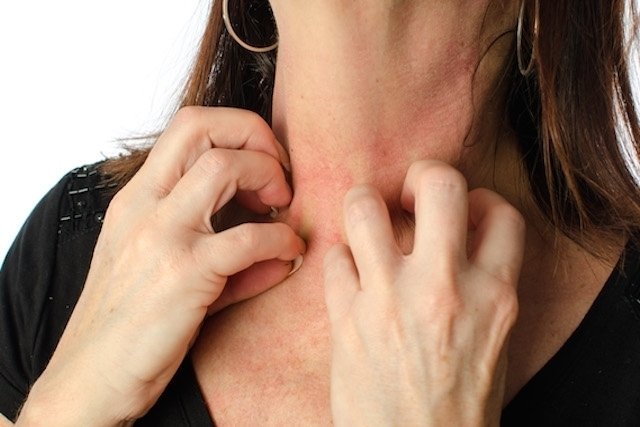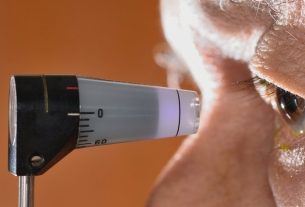calded skin syndrome is a complication of an infection in other parts of the body, caused by some species of bacteria of the genus Staphylococcus, which release a toxic substance, which is transported by the blood to the skin, causing symptoms such as peeling, redness and blistering, leaving the skin with a burned appearance.
This disease is more common in newborns, babies or children under 6 years of age, and may arise due to staphylococcal infections in the umbilical stump, upper respiratory tract, ear or eyes, for example. However, although it is rarer, it can affect older children or adults, especially those with weakened immune systems or serious kidney disease.
The treatment of staphylococcal scalded skin syndrome, also known as Ritter’s disease, is carried out by a dermatologist, pediatrician or general practitioner, with hospitalization, and involves the use of antibiotics and the application of moisturizing creams that accelerate skin recovery.
Sensitive content
This image may contain content that is uncomfortable for some people.

Main symptoms
The main symptoms of staphylococcal scalded skin syndrome are:
- Skin irritation;
- Fever or chills;
- Discomfort;
- Blisters on the skin, which may appear within 24 to 48 hours after exposing the skin to toxins;
- Blisters containing clear liquid or pus;
- Intense pain when touched;
- Intense redness;
- Crusts around the lesions;
- Soft, wrinkled skin at the site of the injury;
- Peeling of the skin;
- Cracks in the skin.
During this worsening process, the top layer of the skin begins to come off in pieces, giving way to burnt-looking skin, with blisters that break easily, also causing other symptoms, such as irritability, loss of appetite, conjunctivitis or even dehydration.
The symptoms of this syndrome appear, most of the time, in the diaper region or around the rest of the umbilical stump, in the case of babies, on the face, in cases of older children, or even in any part of the body, in the case of of adults.
Over time, if the infection is not treated, the toxin continues to spread throughout the body, starting to affect other parts of the body and becoming more visible in places of friction such as the buttocks, skin folds, hands or feet, for example. , which can also cause generalized infection. See the main symptoms of generalized infection.
How to confirm the diagnosis
The diagnosis of staphylococcal scalded skin syndrome is made by a dermatologist, pediatrician or general practitioner, through physical evaluation of the skin, health history and recent staphylococcal infections in the umbilical stump, upper respiratory tract, ear or eyes.
In addition, the doctor may request a skin biopsy, which is done by removing a small piece of skin tissue for analysis under a microscope, in order to look for changes that allow the diagnosis of staphylococcal scalded skin syndrome to be confirmed. and rule out other diseases with similar symptoms, such as toxic epidermal necrolysis, epidermolysis bullosa or bullous impetigo, for example. Find out how a skin biopsy is performed.
Other tests that the doctor may order are a complete blood count and urine tests, to assess whether there is a generalized infection, electrolyte levels in the blood, in case of suspected dehydration, or culture tests from the site of the primary infection or the liquid contained in the blisters. , to confirm the presence of bacteria of the genus Staphylococcus.
Possible causes
Staphylococcal scalded skin syndrome is caused by toxins produced by some subspecies of the bacteria Staphylococcus, due to infections in other parts of the body, such as the upper respiratory tract, eyes, ears or umbilical stump.
These toxins can be transported through the bloodstream and reach the skin, breaking down a protein, desmoglein 1, which is responsible for keeping the cells of the epidermis together, causing the skin to lose its ability to maintain its structure, resulting in symptoms that can be localized or affect the entire body.
The main factor that can increase the risk of developing scalded skin syndrome in newborns or babies is the immaturity of the immune system to fight infections.
In the case of older children or adults, there is an increased risk of developing the syndrome if the person has a health condition that causes a weakening of the immune system, such as HIV infection, or even chronic kidney disease or kidney failure, for example. example.
How the treatment is carried out
The treatment of staphylococcal scalded skin syndrome must be guided by a dermatologist, pediatrician or general practitioner, with hospitalization, and generally consists of the administration of antibiotics intravenously, and later orally. In addition, saline solution can be applied to the vein to prevent or treat dehydration.
Furthermore, during treatment, the doctor should recommend the application of moisturizing creams and non-adherent dressings to the skin, to promote healing, reduce heat loss through the skin, and protect the new skin that forms. The superficial layer of the skin is quickly renewed, healing in about 2 weeks after starting treatment.
In the case of newborns affected by this syndrome, they are normally kept in an incubator.
Possible complications
If staphylococcal scalded skin syndrome is not treated quickly, it can cause complications such as dehydration, electrolyte imbalance in the body, secondary infections, kidney failure or generalized infection.

Sign up for our newsletter and stay up to date with exclusive news
that can transform your routine!
Warning: Undefined array key "title" in /home/storelat/public_html/wp-content/plugins/link-whisper-premium/templates/frontend/related-posts.php on line 12
Warning: Undefined array key "title_tag" in /home/storelat/public_html/wp-content/plugins/link-whisper-premium/templates/frontend/related-posts.php on line 13




